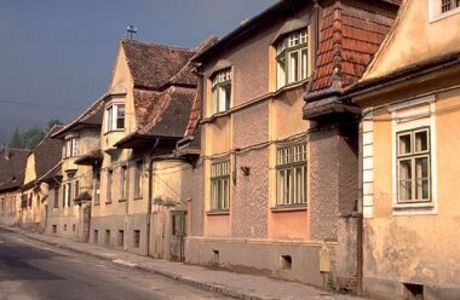Schei district
Strategically located on a hill overlooking the town and the plains to the north, the citadel was part of Brasov's outer fortification system. Built in wood in 1524, it was replaced with a stone structure in the 16th century, only to be abandoned in the 17th century after technological innovations made cannons stronger than the building. Today, it serves as a restaurant.
One shouldn't leave Brasov without a stroll through Schei, the old Romanian district of Brasov, a neighborhood of narrow cobblestone streets and red-tiled 17th century homes. Leave the fortress area of the old city trough Poarta Schei and you'll find yourself in this picturesque suburb.
Poarta Schei used to be the only entrance for the Romanians living in Schei. They were not allowed to use the other four entrances. During the Saxon rule of the 13th to 17th century Romanians were forbidden from owning property inside the fortress walls and such they settled outside the wall, building their homes outside the city walls, up this beautiful valley. Romanians could only enter the town at certain times and had to pay a toll at the gate for the privilege of selling their produce inside the citadel.
Leaving the Schei Gate behind you, walk up Strada Prundului to Piata Unirii. There you can visit the gorgeously painted Romanian Orthodox church of St Nicholas and the First Romanian school, which is right next to the church. Then just wander around the small curving streets that gradually slope upwards against the hill. Note the many different iron door handles and knockers adorning the pretty houses. You'll also notice many roadside crosses, each one with its unique story. At the end of the valley,you can trek on the old road to Poiana Brasov, Romania's most famous skiing resort.
Walk on to the southern end of Schei and you'll end up on the gravel road to the impressive Salomon Rocks (Pietrele lui Salomon). This is where every spring thousands of Romanians gather for a massive picnic and sing-along, after having followed the traditional Junii-procession through town, celebrating the one day a year that Romanians were allowed to freely enter the Saxon town. The "Feast of Youth" takes place the first Week after Easter. This is a festival of the lads and of the men from Schei. They ride their horses and they march down on the streets of the city. The atmosphere is festive: traditional costumes, adorned horses, music. This custom is considered a kind of initiation ritual, when the boys are supposed to pass some tests of maturity and bravery: throwing the mace, springing them up into the air in a counterpane.
This is how, Ileana, the Princess of Romania described Schei in her book "Hospital of the Queen's Heart", written in 1954:
"The Schei is a tight little valley, its population of about one thousand peasants crowded together into an area so long and narrow that it seems but a crevice between two up thrusting mountains, their sides rising sheer and darkly forested. The unpaved streets are narrow, and the little whitewashed houses huddle together along them as if pressed ever more and more close by the overhanging mountains on either side. Because the valley is so sheltered, it is a veritable paradise of little gardens and fruit trees that are seemingly pushed up against the houses for lack of space. In the spring blue Scylla, daffodils, and narcissus come early through the snow and carpet the warm little valley, and, later, clouds of plum and apple, apricot and cherry blossoms seem to float low over the whole town, drenching it with perfume, shaking down their soft rain of pink and white petals over tiled and shingled roofs, onto the ground. There is no room for growing things to expand, so they flourish and blossom beyond belief.
In winter, the town is still and somnolent, buried beneath deep snowdrifts. Paths are trod out, snowed over again, and retrodden from house to house, to shop and church and school. Life goes at a slower pace until the long rays of the returning sun, penetrating the depths of the valley, quicken the people's lives as they do the green growing things.
The people of the Schei are intensely Romanian, profoundly Orthodox and reactionary. They resented the Communists with all the fervor of their long and loyal past. In 1945, they refused to take part in the celebrations and demonstrations on May first, the first Communist Labor Day since the new regime had taken over the country. For a half mile they deliberately tore up the road leading into the town and then barricaded the valley.




